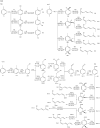A theoretical study on toluene oxidization by OH radical
- PMID: 38609951
- PMCID: PMC11015615
- DOI: 10.1186/s13065-024-01163-w
A theoretical study on toluene oxidization by OH radical
Abstract
Toluene, a prominent member of volatile organic compounds (VOCs), exerts a substantial adverse influence on both human life and the environment. In the context of advanced oxidation processes, the ·OH radical emerges as a highly efficient oxidant, pivotal in the elimination of VOCs. This study employs computational quantum chemistry methods (G4MP2//B3LYP/6-311++G(d,p)) to systematically investigate the degradation of toluene by ·OH radicals in an implicit solvent model, and validates the rationale of choosing a single-reference method using T1 diagnostics. Our results suggest three possible reaction mechanisms for the oxidation of toluene by ·OH: firstly, the phenyl ring undergoes a hydrogen abstraction reaction followed by direct combination with ·OH to form cresol; secondly, ·OH directly adds to the phenyl ring, leading to ring opening; thirdly, oxidation of sidechain to benzoic acid followed by further addition and ring opening. The last two oxidation pathways involve the ring opening of toluene via the addition of ·OH, significantly facilitating the process. Therefore, both pathways are considered feasible for the degradation of toluene. Subsequently, the UV-H2O2 system was designed to induce the formation of ·OH for toluene degradation and to identify the optimal reaction conditions. It was demonstrated that ·OH and 1O2 are the primary active species for degrading toluene, with their contribution ranking as ·OH > 1O2. The intermediates in the mixture solution after reactions were characterized using GC-MS, demonstrating the validity of theoretical predictions. A comparative study of the toluene consumption rate revealed an experimental comprehensive activation energy of 10.33 kJ/mol, which is consistent with the preliminary activation energies obtained via theoretical analysis of these three mechanisms (0.56 kJ/mol to 13.66 kJ/mol), indicating that this theoretical method can provide a theoretical basis for experimental studies on the oxidation of toluene by ·OH.
Keywords: Advanced oxidation; Quantum chemical calculations; Reaction mechanism; ·OH.
© 2024. The Author(s).
Conflict of interest statement
The authors have no relevant financial or non-financial interests to disclose.
Figures








Similar articles
-
Unveiling the activity difference cause and ring-opening reaction routes of typical radicals induced degradation of toluene.J Hazard Mater. 2024 Jun 5;471:134273. doi: 10.1016/j.jhazmat.2024.134273. Epub 2024 Apr 12. J Hazard Mater. 2024. PMID: 38653137
-
OH-initiated oxidation of toluene. 3. Low-energy routes to cresol and oxoheptadienal.J Phys Chem A. 2008 Feb 21;112(7):1572-5. doi: 10.1021/jp710446r. Epub 2008 Jan 29. J Phys Chem A. 2008. PMID: 18225876
-
Toluene combustion: reaction paths, thermochemical properties, and kinetic analysis for the methylphenyl radical + O2 reaction.J Phys Chem A. 2007 Sep 6;111(35):8663-76. doi: 10.1021/jp068640x. Epub 2007 Aug 16. J Phys Chem A. 2007. PMID: 17696501
-
The removal of toluene by thermoscatalytic oxidation using CeO2-based catalysts:a review.Chemosphere. 2024 Mar;351:141253. doi: 10.1016/j.chemosphere.2024.141253. Epub 2024 Jan 17. Chemosphere. 2024. PMID: 38242517 Review.
-
Reaction Steps in Heterogeneous Photocatalytic Oxidation of Toluene in Gas Phase-A Review.Molecules. 2023 Sep 6;28(18):6451. doi: 10.3390/molecules28186451. Molecules. 2023. PMID: 37764227 Free PMC article. Review.
References
-
- Brimblecombe P. Air composition & chemistry. Cambridge University Press; 1996.
-
- Cerón Bretón JG, Cerón Bretón RM, Martínez Morales S, et al. Health risk assessment of the levels of BTEX in ambient air of one urban site located in Leon, Guanajuato Mexico during two climatic seasons. Atmosphere. 2020;11(2):165. doi: 10.3390/atmos11020165. - DOI
LinkOut - more resources
Full Text Sources
Miscellaneous
